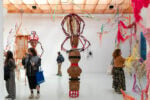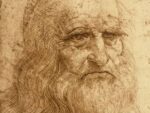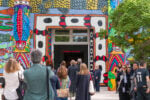Tania Fiaccadori – Sea-Monkeys Cult
.jpg)
Dimora Artica presenta Sea-Monkeys Cult di Tania Fiaccadori, mostra personale che riflette sul concetto di sopravvivenza (Nachleben) in relazione al potere simbolico degli oggetti e delle immagini e al suo eterno ritorno attraverso la storia.
Comunicato stampa
Dimora Artica presenta Sea-Monkeys Cult di Tania Fiaccadori, mostra personale che riflette sul concetto di sopravvivenza (Nachleben) in relazione al potere simbolico degli oggetti e delle immagini e al suo eterno ritorno attraverso la storia. Le opere, che si ispirano agli strumenti magici delle antiche tradizioni italiane, ripropongono una forma espressiva rituale riveduta attraverso il filtro della contemporaneità, come fossero parte di un culto a noi alieno.
-
Come in passato, nella contemporaneità permane il valore prodigioso ed identitario associato agli oggetti che, traslati dalla quotidianità alla dimensione magica, hanno il potere di trasportare in un altrove emancipativo. Tale dimensione ha sempre rivestito un ruolo di primaria importanza nell'agire umano, e si è spesso manifestata in ritualità che sfuggivano alle norme religiose dominanti. Nella cultura europea molte antiche tradizioni sono state dimenticate, ma altre perdurano nella memoria popolare: echi di queste usanze persisterebbero nelle superstizioni o in semplici riti tramandati di generazione in generazione. Un insieme assimilabile alle vestigia di un'Europa e di un'Italia pagane, in grado di sopravvivere in clandestinità nonostante l'avvento della religione cristiana, del medioevo, del tentativo di cancellarne la memoria bollandone i rituali come culti demonici. L'antropologo C. G. Leland raccolse a fine '800 alcune di queste tradizioni nel libro Aradia, o il Vangelo delle Streghe, a partire dalla corrispondenza con una strega fiorentina, a suo dire di ascendenza etrusca, che ancora ricordava i frammenti di questa antica devozione: figura centrale nel racconto era Aradia, figlia della dea Diana e regina delle streghe.
In Sea-Monkeys Cult il racconto di Aradia funge da manifesto suggestivo di una modalità di operare che si avvale di oggetti di uso quotidiano a cui vengono attribuiti significati “altri”, non dissimile appunto da quella che interviene nella pratica rituale, la quale rifiuta la logica procedendo per similitudini e correlazioni occulte fra elementi diversi e gesti significatori dell'operatore. Nella mostra quindi i singoli elementi fanno parte di un processo che porta al compimento del rituale secondo una precisa simbologia (esemplificata dallo stendardo). Dimora Artica diventa l'ambiente in cui operare segretamente con questi strumenti magici, una sorta di antro della strega, trasfigurato però attraverso il filtro della contemporaneità.
Per compiere i riti tradizionali si utilizzavano spesso oggetti semplici, facilmente reperibili: il sale deteneva un grande potere protettivo ed era ritenuto in grado di bandire le forze del male; mentre un'operazione magica poteva essere compiuta anche con l'utilizzo di un semplice indumento, ad esempio sottraendo le scarpe a una persona e inserendovi in alcuni casi degli oggetti consacrati, o una formula: in questo modo si poteva lanciare il malocchio o compiere un incantesimo di altro genere sul possessore dell'oggetto. Anche ai denti era attribuita grande importanza: perderli e gettarli era un segno di sventura, per questo si usava conservarli, anche in reliquiari – come ancora si fa coi denti da latte. Questi oggetti si caricavano di significati spesso estranei alla loro funzione pratica, e nel sentire della gente che ne faceva uso erano ammantati di un'energia inspiegabile. Così in Sea-Monkeys Cult le opere rappresentano una possibile serie di strumenti magici trasfigurati, parte di un culto a noi alieno. L'insieme della mostra suggerisce come ancora, ipotizzando nell'oggi una sopravvivenza del pensiero magico, certi oggetti che di per sé non avrebbero nulla di speciale acquistino invece un certo potere, ad esempio nelle sottoculture, esprimendo una libera trascendenza. Come se fossero investiti da un’aura magica, strumenti, indumenti firmati, accessori sportivi, ma anche certe immagini, loghi e simboli, diventano elementi “di culto”.
Il potere simbolico degli oggetti (o delle immagini) ritorna quindi nella storia sotto altre forme, e si rimanifesta in contesti diversi mantenendo intatta un’energia ineffabile, mai morto ma sempre “sopravvissuto”. Warburg chiama questa sopravvivenza Nachleben, non tanto una rinascita dopo un'estinzione, ma una non-morte fantasmatica, una continuità: similmente a quanto accaduto agli antichi riti perdurati fino ad oggi, attraverso metamorfosi sotterranee.
In Sea-Monkeys Cult il rito che si compie, esemplificato dalle opere, ricalca il ciclo vitale dell'Artemia salina, un millenario fossile vivente volgarmente chiamato scimmia di mare e divenuto gioco educativo per bambini (incidentalmente l'Artemia è l'unico essere della famiglia delle Artemiidae, dal nome greco di Diana): un organismo quasi immortale, le cui uova possono apparire come morte per centinaia d'anni, e poi, in condizioni ambientali favorevoli, schiudersi come per miracolo. Il sale è lo strumento magico che, unito all'acqua, funge da attivatore; e che insieme alla luce - seconda chiave - determina la rinascita dopo una morte apparente di questa divinità infinitesimale.
---
TANIA FIACCADORI
SEA-MONKEYS CULT
Opening: Wednesday, March 7th at 18:30
The exhibition will be open: From March 7th to April 7th, 2018 by appointment only
Location: DIMORA ARTICA, via Matteo Maria Boiardo 11 – Milano (MM1 Turro)
Dimora Artica presents Sea-Monkeys Cult by Tania Fiaccadori, a personal exhibition that reflects on the concept of survival (Nachleben) in relation to the symbolic power of objects and images and their eternal return through history. The works, inspired by the magical instruments of the ancient Italian traditions, reproduce a ritual expressive form seen through a contemporary filter, as if they were part of an alien cult.
-
Objects retain a prodigious and identitarian value in the contemporary world just like they did in the past, and if transferred from everyday life to the magical dimension, they have the power to transport into an emancipatory elsewhere. This magical dimension always played a main role in human behavior, and often manifested itself in rituals that escaped the dominant religious norms. In European culture many ancient traditions have been forgotten, but others persist in the people’s memories: echoes of these customs persist in superstitions or in simple rituals handed down from generation to generation. This set of habits can be linked to the vestiges of a pagan Europe and Italy, able to survive in hiding despite the advent of the Christian religion, the Middle Ages, the attempt to erase their memory by branding their rituals as demonic cults. At the end of the 19th century the anthropologist C. G. Leland collected some of these traditions in the book Aradia, or the Gospel of the Witches, starting from the correspondence with a Florentine witch who claimed to be a descendant of the Etruscans and still remembered the fragments of their ancient devotions. The central figure of the sacred text was Aradia, daughter of the goddess Diana and queen of witches.
In Sea-Monkeys Cult, Aradia's story serves as an evocative manifesto of an operative method that makes use of everyday objects attributing complex meanings to them, not unlike the ritual practice, that often follows a non-logical pattern, proceeding through hidden similarities and correlations between different elements and the gestures of the officiant. Therefore in the exhibition the single elements are part of a process that leads to the completion of the ritual according to a precise symbolism (exemplified by the black banner). Dimora Artica becomes the environment in which the operation carried on with these magical instruments takes place, a sort of witch’s house, transfigured through the filters of the contemporary approach. Traditional rituals were performed with easily available and simple objects: for example salt held a great protective power and was able to banish the forces of evil. A magical operation could also be accomplished using a simple garment: stealing the shoes from someone and inserting some kind of consecrated object, or a written magic formula: in this way a jinx or some other form of spell could be cast on the owner of the object. Teeth were held in great consideration as well: losing them and throwing them away was a sign of misfortune, therefore they used to be conserved, even in reliquaries - as today is sometimes done with milk teeth. These objects were loaded with meanings often unrelated to their practical function, and the owners felt as if they were charged with inexplicable energy. In Sea-Monkeys Cult the works represent a possible series of transfigured magic instruments, part of an alien cult. The whole exhibition suggests how still today, hypothesizing a survival of magical thinking, certain objects with nothing special in themselves acquire instead a certain power, for example in subcultures, expressing a freedom of transcendence. As if they gained a magical aura, instruments, designer clothes, sports accessories, but also certain images, logos and symbols, become "cult" elements.
The symbolic power of objects (or images) is re-established in different contexts, returning throughout history in different forms, keeping intact an ineffable energy, never dead but always "survived". Warburg calls this survival Nachleben, not really a rebirth after extinction, but a ghostly non-death, a continuity: similar to what happened to the ancient rites that lasted until today, through underground metamorphoses.
In Sea-Monkeys Cult the ritual performed, exemplified by the works, follows the life cycle of the Artemia salina, a millenary living fossil commonly called “sea-monkey”, that has become an educational game for children (incidentally the Artemia is the only being part of the Artemiidae family, named after the Greek name of Diana): an organism which is almost immortal, whose eggs may appear dead for hundreds of years, and then, under favorable environmental conditions, open as if it was a miracle. Salt is the magic tool that, combined with water, acts as an activator; and that together with light - the second key – makes the rebirth after an apparent death of this infinitesimal divinity possible.



